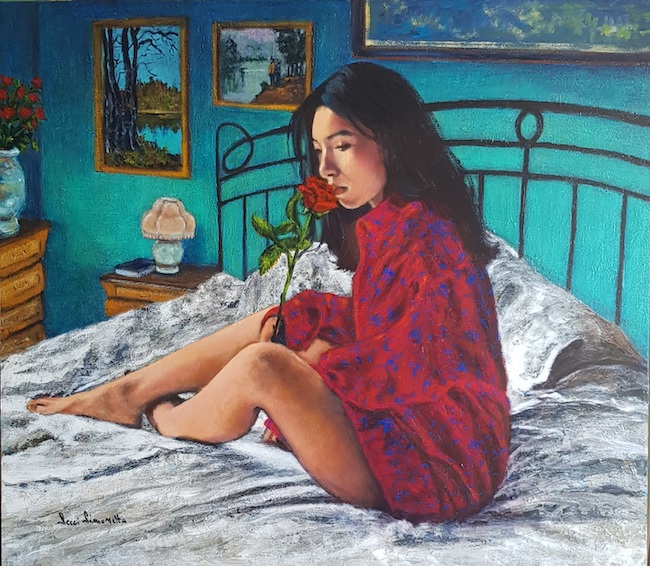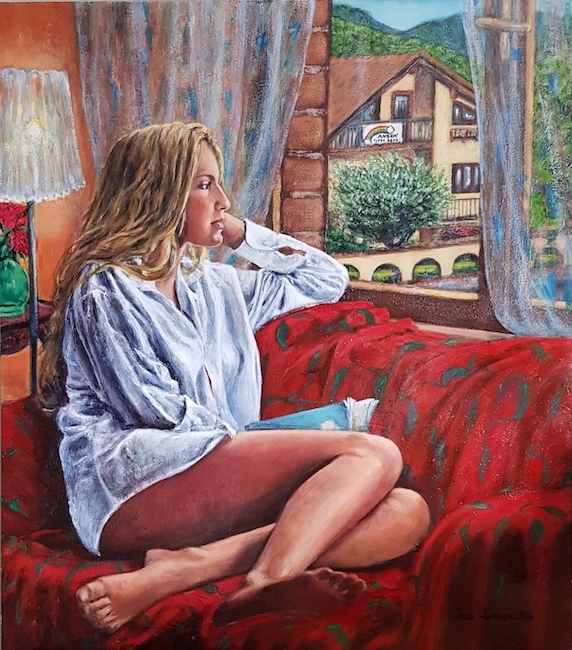La riflessione su se stessi, sulle proprie emozioni e sensazioni senza l’urgenza e l’impellenza del passato bensì con la libertà di un approccio più interiore e meno formale rispetto alla precedente tradizione artistica, è un percorso che intraprendono molti creativi contemporanei, ciascuno scegliendo il proprio personale linguaggio, più o meno implicito o criptico sulla base della propria personalità espressiva. La protagonista di oggi affronta il cammino introspettivo attraverso uno stile chiaro, manifesto, facilmente riconoscibile dall’osservatore che ritrova nei tratti conosciuti una parte delle sue stesse emozioni.
A partire da fine Ottocento gli artisti cominciarono ad avvertire l’esigenza di distaccarsi dal formalismo spesso impersonale che contraddistingueva gli stili precedenti, cercando un modo per liberare quelle emozioni che dovevano fuoriuscire spesso in maniera persino irruenta, impetuosa; la sperimentazione dei Fauves prima e dell’Espressionismo poi condussero la manifestazione pittorica verso un livello differente, più attento alle pulsioni interiori che non potevano più essere trascurare o messe a tacere a vantaggio di un equilibrio puramente estetico, di un’armonia delle forme che però rischiava di apparire fredda e distaccata. Il percorso successivo a quella prima fase liberatoria espressa magistralmente dalle atmosfere cupe e distorte di Edvard Munch o da quelle irrequiete di Vincent Van Gogh, fu un’esplorazione più ampia, su piani descrittivi differenti che andavano dal mondo onirico e inquietante del Surrealismo all’approccio meditativo e silenzioso del Color Field di Mark Rothko, esponente dell’Espressionismo Astratto, fino a giungere lentamente nel corso del Ventesimo secolo alla consapevolezza che l’arte non può distaccarsi dall’emotività o dalla riflessione mentale perché è proprio quella connessione con l’interiorità a costituirne l’essenza stessa senza la quale l’osservatore si sentirebbe lontano da un’opera. Anche il Realismo, che tanto fu osteggiato dalle avanguardie del periodo a cavallo tra fine Ottocento e inizi Novecento, subì una sostanziale trasformazione e da stile che metteva l’estetica e la perfezione della forma al centro della sua linea base divenne un ulteriore mezzo per narrare i moti interiori in maniera diretta, limpida, senza filtri di distorsioni cromatiche e figurative, senza la necessità di evidenziare un enigma, un mistero o un incubo, per descrivere ciò che all’interno dell’animo umano, attraverso lo sguardo dell’artista, si liberava dai soggetti rappresentati. Dunque non più l’impellenza di lasciar fuoriuscire impetuosamente tutto ciò che era stato in precedenza trattenuto, non più la necessità di gridare forte per imporre un pensiero, un vigoroso tendere verso una realtà a lungo lasciata in disparte, bensì la serenità di essere coscienti della libertà acquisita di poter introdurre nel rinnovamento dello stile tutti quei moti interni che avvolgono l’esistenza e che viaggiano al fianco della quotidianità. È esattamente su questa modalità espressiva che si colloca lo stile pittorico di Simonetta Secci, artista di origini sarde trasferitasi in provincia di Torino da lungo tempo, e che fin da bambina sente quell’estro artistico che coltiva come hobby fino al momento in cui l’esigenza di dedicarsi a tempo pieno a qualcosa che la fa sentire davvero appagata non può più rimanere inascoltata.

Il suo stile è Realista ma intriso di quell’atmosfera interiore, introspettiva che emerge dalle sue tele sotto forma di nostalgia, di innocenza, di delicatezza, di tutto quel ventaglio di sensazioni che avvolgono l’essere umano, che lo inducono a guardarsi dentro oppure semplicemente a vivere e assaporare gli eventi, così come sanno fare i bambini, soggetti spesso protagonisti delle sue opere.
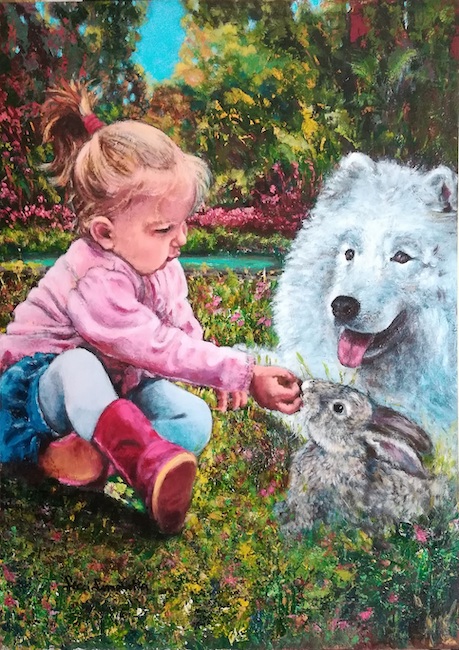
La Secci affronta temi complessi e sfaccettati dando un punto di vista poliedrico che può essere liberamente interpretato dall’osservatore sulla base delle sue personali sensazioni, del suo sentire generato dal percorso della sua esistenza, sulle esperienze vissute; le emozioni non traspaiono solo dai volti dei personaggi bensì anche dalle loro pose, dall’intensità dei gesti e persino dell’ambiente circostante che sembra compartecipare, porsi in accordo melodico generando un’atmosfera da cui il soggetto stesso non può prescindere in virtù di quell’istante magico colto dall’artista e che lega indissolubilmente gli oggetti e i contesti di sfondo ai protagonisti in primo piano.
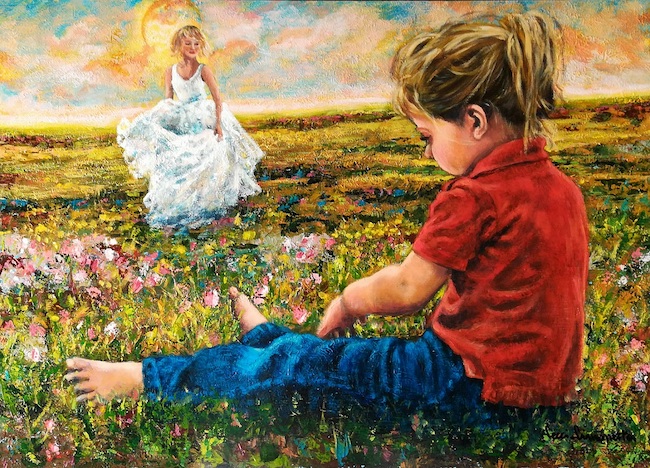
Nella tela Il sogno la bambina, nella sua innocenza e spontaneità, immagina se stessa da adulta, avvolta dalla medesima leggerezza e spensieratezza che contraddistingue la lei bambina, inconscia che molto spesso invece la realtà è differente, che il percorso di crescita induce a perdere un po’ della purezza fanciullesca per autodifendersi da un mondo meno empatico, meno aperto e sereno di quello infantile; la Secci riesce a infondere quel senso di candore nella bimba malgrado il suo volto non sia visibile se non di profilo eppure la connessione tra il contesto circostante e la sua posizione di gioco, di concentrazione sul benessere che le infonde la natura, riesce a lasciar trapelare le emozioni più profonde, quella filo diretto con il mondo dei sogni che appartiene a un’età in cui tutto è ancora bello, divertente, tutto è ancora da scoprire.
Lo stesso tema si ripete nel dipinto Spensieratezza in cui l’artista narra di un momento di gioco, un istante in cui l’adulta, forse la mamma delle bambine che le corrono intorno, si lascia contagiare e coinvolgere dalla loro allegria, dal loro travolgente entusiasmo nel compiere delle azioni talmente semplici da risultare disarmanti; così la donna dimentica per un momento la contingenza e ritrova il contatto con la purezza della sua infanzia, lasciandosi andare, permettendo alla leggerezza, espressa dai palloncini che tiene in mano, di prendere il sopravvento. In queste opere si nasconde un messaggio della Secci, un’esortazione a non dimenticare mai il lato fanciullesco, a mantenere quella connessione con il bambino che è dentro ciascun essere umano perché è esattamente grazie a lui che è possibile ritrovare la serenità perduta all’interno della quotidianità, rendendo straordinari alcuni istanti che altrimenti rimarrebbero dettagli ordinari di una vita che scorre fin troppo rapidamente. In L’11 marzo 2020
Simonetta Secci affronta invece un tema attuale, un periodo buio della storia contemporanea, quello dopo il quale ogni cosa è cambiata, quello in cui la socialità, i contatti umani, la possibilità di uscire e incontrarsi, necessità innata nell’essere umano, è stata cancellata dall’obbligo al confinamento, alla necessità di dover restare in casa per salvaguardare la propria salute e quella dei propri cari. La donna protagonista guarda verso la finestra con timore ma al tempo stesso con il desiderio di uscire presto da quella gabbia dorata, di tornare a quella normalità strappata via da un nemico invisibile eppure tangibile; in quest’opera l’esterno costituisce non tanto la nostalgia quanto la speranza, l’opportunità che troppo spesso non è stata apprezzata perché vissuta come certezza acquisita, abitudine a una quotidianità che, a seguito dell’evento pandemico, ha accresciuto la sua importanza all’interno dell’esistenza inducendo la protagonista a desiderare ciò che in precedenza era semplicemente parte del vivere.

E ancora, nella tela Ricordi in bianco e nero, lo stesso approccio malinconico viene affidato a un’anziana, appartenente a quella categoria che invece spesso si ritrova a dover trascorrere la maggior parte del tempo in casa, questo a prescindere da tutto ciò che è accaduto negli ultimi due anni della storia contemporanea, che non riesce a fare a meno di ricordare i momenti belli che hanno costellato la sua esistenza, quei frammenti di memoria, rappresentati dalla Secci con un’immagine in bianco e nero, che allietano il suo cammino verso la fine della vita. Ed è proprio in virtù di quei ricordi che riesce a sentirsi serena malgrado la solitudine e l’isolamento che contraddistingue il suo presente.
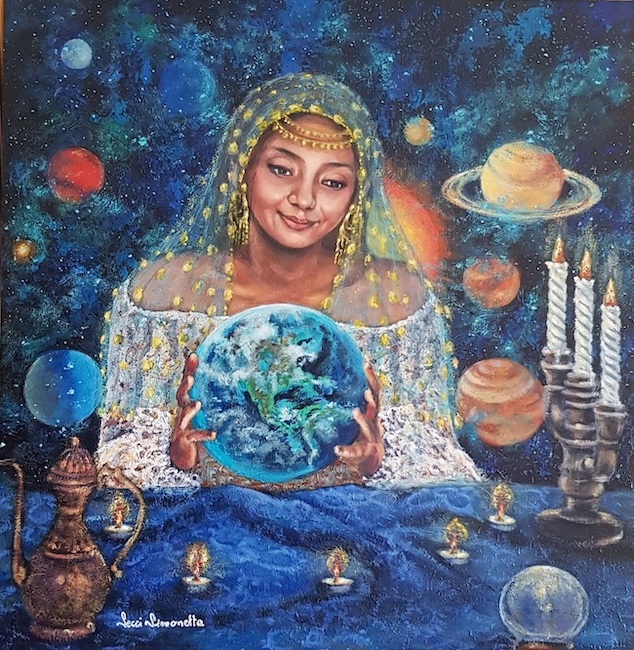
Simonetta Secci ha al suo attivo molte mostre personali e collettive su tutto il territorio nazionale, ha sempre riscosso un grande successo di pubblico e ricevuto diversi premi da parte degli addetti ai lavori.
SIMONETTA SECCI-CONTATTI
Email: simonettasecci@libero.it
Sito web: www.simonettasecci-pittrice.it
Facebook: https://www.facebook.com/simonetta.secci.9
Instagram: https://www.instagram.com/simonettasecci/
Nostalgia and introspection in the Realist artworks of Simonetta Secci
The reflection on oneself, on one’s own emotions and sensations without the urgency and the impellence of the past but with the freedom of a more interior and less formal approach compared to the previous artistic tradition, is a path that many contemporary creatives undertake, each one choosing his own personal language, more or less implicit or cryptic on the basis of their own expressive personality. Today’s protagonist faces the introspective path through a clear, manifest style, easily recognizable by the observer who finds in the known traits a part of his own emotions.
Starting from the end of the nineteenth century, artists began to feel the need to detach themselves from the often impersonal formalism that distinguished the previous styles, looking for a way to release those emotions that had to come out often in an impetuous way; the experimentation of the Fauves first and then of Expressionism led the pictorial manifestation towards a different level, more attentive to the inner drives that could no longer be neglected or silenced to the advantage of a purely aesthetic balance, of a harmony of forms that risked appearing cold and detached. The path that followed that first liberating phase, masterfully expressed by the dark and distorted atmospheres of Edvard Munch or by the restless ones of Vincent Van Gogh, was a wider exploration, on different descriptive plans that went from the dreamlike and disturbing world of Surrealism to the meditative and silent approach of Color Field of Mark Rothko, an exponent of Abstract Expressionism, until slowly, in the course of the twentieth century, we came to the realization that art cannot detach itself from emotionality or mental reflection because it is precisely that connection with interiority that constitutes the very essence without which the observer would feel distant from an artwork. Realism, which was opposed by the avant-garde movements of the period between the end of the nineteenth century and the beginning of the twentieth, underwent a substantial transformation, and from a style that placed aesthetics and perfection of form at the center of its base line, it became a further means of narrating inner movements in a direct manner, clear, without filters of chromatic and figurative distortions, without the need to highlight an enigma, a mystery or a nightmare, to describe what inside the human soul, through the gaze of the artist, was released from the subjects represented.
Therefore, there was no longer the urge to let everything that had been previously held back escape impetuously, no longer the need to shout loudly in order to impose a thought, a vigorous striving towards a reality that had been left aside for a long time, but rather the serenity of being aware of the freedom acquired to be able to introduce into the renewal of the style all those internal motions that envelop existence and that travel alongside everyday life. It is exactly on this expressive modality that is placed the pictorial style of Simonetta Secci, artist of Sardinian origins moved to the province of Turin since a long time, and that since she was a child she has felt that artistic inspiration that she has cultivated as a hobby until the moment in which the need to dedicate herself full time to something that makes her feel really satisfied couldn’t have remained unheard anymore. Her style is realistic but imbued with that inner atmosphere, introspective that emerges from her canvases in the form of nostalgia, innocence, delicacy, all that range of sensations that envelop the human being, which lead him to look inside or simply to live and enjoy the events, as well as children, subjects often protagonists of her paintings. Secci deals with complex and multifaceted themes giving a polyhedral point of view that can be freely interpreted by the observer on the basis of his personal sensations, of his feeling generated by the path of his existence, on his experiences; the emotions do not transpire only from the faces of the characters but also from their poses, from the intensity of the gestures and even of the surrounding environment that seems to participate, to place itself in melodic accord generating an atmosphere from which the subject itself cannot prescind in virtue of that magical instant captured by the artist and that binds indissolubly the objects and the background contexts to the protagonists in the foreground.
In the canvas Il Sogno (The Dream) the little girl, in her innocence and spontaneity, imagines herself as an adult, wrapped in the same lightness and carefreeness that distinguishes her as a child, unaware that very often reality is different, that the path of growth leads to lose some of the childish purity to defend themselves from a world less empathetic, less open and serene than that of infancy; Secci succeeds in instilling that sense of candor in the baby girl despite the fact that her face is not visible except in profile, yet the connection between the surrounding context and her position of play, of concentration on the well-being that nature instills in her, succeeds in allowing the deepest emotions to seep out, that direct line with the world of dreams that belongs to an age in which everything is still beautiful, fun, everything is still to be discovered. The same theme is repeated in the painting Spensieratezza (Carefreeness), in which the artist narrates a moment of play, an instant in which the adult, perhaps the mother of the children who run around her, lets herself be infected and involved by their joy, by their overwhelming enthusiasm in carrying out actions so simple as to be disarming; thus the woman forgets for a moment the contingency and regains contact with the purity of her childhood, letting herself go, allowing the lightness, expressed by the balloons she holds in her hand, to take over. In these paintings lies a message from Secci, an exhortation to never forget the childlike side, to maintain that connection with the child that is inside every human being because it is precisely thanks to him that it is possible to find the serenity lost in everyday life, making extraordinary some moments that would otherwise remain ordinary details of a life that flows all too quickly. In L’11 marzo 2020 (11th of March 2020) Simonetta Secci faces a current theme, a dark period of contemporary history, the one after which everything changed, the one in which sociality, human contacts, the possibility to go out and meet each other, an innate necessity in human beings, was cancelled by the obligation to confinement, to the necessity of having to stay at home to safeguard one’s own health and that of the beloved ones.
The woman protagonist looks towards the window with fear but at the same time with the desire to get out of that gilded cage soon, to return to that normality torn away by an invisible yet tangible enemy; in this artwork, the outside is not so much nostalgia but hope, the opportunity that too often has not been appreciated because it has been experienced as an acquired certainty, a habit of daily life that, following the pandemic event, has increased its importance in existence, leading the protagonist to desire what was previously simply part of living. And again, in the canvas Ricordi in bianco e nero (Memories in black and white), the same melancholic approach is entrusted to an elderly woman, belonging to that category that often finds itself having to spend most of its time at home, regardless of everything that has happened in the last two years of contemporary history, which can not help but remember the beautiful moments that have dotted her existence, those fragments of memory, represented by Secci with an image in black and white, which brighten her path to the end of life. And it is precisely because of those memories that she manages to feel serene despite the solitude and isolation that characterizes her present. Simonetta Secci has to her credit many personal and collective exhibitions throughout the country, she has always been a great success with the public and received several awards from art experts.


